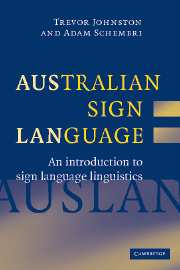Book contents
- Frontmatter
- Contents
- Acknowledgements
- Conventions for sign notation
- 1 Signed languages and linguistics
- 2 Auslan in social context
- 3 Auslan and other signed languages
- 4 Phonetics and phonology: the building blocks of signs
- 5 Morphology: sign formation and modification
- 6 Lexicon: the structure of Auslan vocabulary
- 7 Syntax: the structure of sentences in Auslan
- 8 Semantics and pragmatics: sign meaning and sentence meaning
- 9 Discourse: structure and use above the sentence
- 10 Issues in the study of signed languages
- References
- Index
3 - Auslan and other signed languages
Published online by Cambridge University Press: 02 December 2009
- Frontmatter
- Contents
- Acknowledgements
- Conventions for sign notation
- 1 Signed languages and linguistics
- 2 Auslan in social context
- 3 Auslan and other signed languages
- 4 Phonetics and phonology: the building blocks of signs
- 5 Morphology: sign formation and modification
- 6 Lexicon: the structure of Auslan vocabulary
- 7 Syntax: the structure of sentences in Auslan
- 8 Semantics and pragmatics: sign meaning and sentence meaning
- 9 Discourse: structure and use above the sentence
- 10 Issues in the study of signed languages
- References
- Index
Summary
In this chapter, we look at the relationship between Auslan and other signed languages. First, we examine the traditional use of signed languages in Aboriginal Australia, before moving on to discuss the links between Auslan and other signed languages from the BSL family, including BSL itself and NZSL. We briefly describe the influence of ISL on Auslan, and the relationship between ASL and other signed languages in the BSL family. We close with a discussion of International Sign, and emerging signed languages in the developing world.
Signed languages of Aboriginal Australia
Signed languages were used by Aboriginal Australians prior to the British occupation and settlement of the continent in 1788. Indeed, some indigenous signed languages, such as Warlpiri Sign Language, have survived to the present day (Kendon, 1988). Unlike the signed languages of deaf communities however, all available evidence suggests that Aboriginal signed languages have always been alternate signed languages used instead of or together with speech for a range of purposes, such as to ensure silence while stalking prey during hunting (Sebeok, 1978) or while observing periods of speech taboo when in mourning (Kendon, 1988). Among the Warlpiri and Warumungu people, these natural sign systems (which Kendon referred to as alternate sign languages) are quite rich, allowing communication about any topic in daily life. For the most part, each Aboriginal signed language represents the spoken language(s) of a particular tribe rather than being a natural (or primary) signed language.
- Type
- Chapter
- Information
- Australian Sign Language (Auslan)An introduction to sign language linguistics, pp. 53 - 76Publisher: Cambridge University PressPrint publication year: 2007



